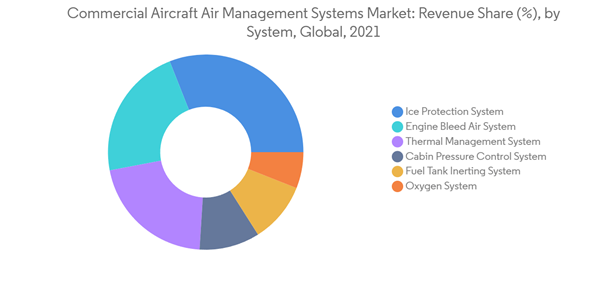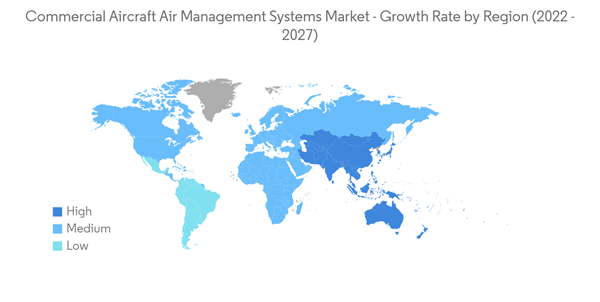The commercial aircraft air management systems market is estimated to record a CAGR of about 4.27% during the forecast period.
Due to the impact of COVID-19, the aviation industry was greatly affected globally, which led to a significant decrease in passenger traffic in 2020. This has led to a decrease in production rates of commercial aircraft programs by the aircraft OEMs and a decrease in aircraft orders and deliveries in 2020. However, the aircraft deliveries and orders witnessed a significant increase in 2021 due to the gradual recovery in passenger traffic.
The gradual recovery of passenger traffic is propelling the airlines, and aircraft operators are investing in fleet modernization initiatives and expansion of their fleet to cater to increasing routes across the various regions. This factor is propelling the market growth for commercial aircraft and, subsequently, commercial aircraft materials.
The aircraft and related subsystems industries are technology-driven. Currently, the replacement of conventional sensors with new and advanced sensors, which yield better and more accurate results, and the development of robust heat exchangers are helping the production of more efficient air management systems.
This product will be delivered within 2 business days.
Due to the impact of COVID-19, the aviation industry was greatly affected globally, which led to a significant decrease in passenger traffic in 2020. This has led to a decrease in production rates of commercial aircraft programs by the aircraft OEMs and a decrease in aircraft orders and deliveries in 2020. However, the aircraft deliveries and orders witnessed a significant increase in 2021 due to the gradual recovery in passenger traffic.
The gradual recovery of passenger traffic is propelling the airlines, and aircraft operators are investing in fleet modernization initiatives and expansion of their fleet to cater to increasing routes across the various regions. This factor is propelling the market growth for commercial aircraft and, subsequently, commercial aircraft materials.
The aircraft and related subsystems industries are technology-driven. Currently, the replacement of conventional sensors with new and advanced sensors, which yield better and more accurate results, and the development of robust heat exchangers are helping the production of more efficient air management systems.
Key Market Trends
Ice Protection Systems Held the Largest Market Share in 2021
In 2021, the ice protection systems segment held the largest market share in the commercial aircraft air management system market. The architecture of an aircraft makes it vulnerable to the detrimental effects of ice formation on the exposed surfaces of the aircraft, such as control surfaces, wings, engine inlets, fan blades, and other parts of the aircraft that are exposed to extreme cold conditions. In cold weather conditions, the accumulation of ice on the wings can lead to catastrophic effects, like the stalling of aircraft. Thus, the integration of ice protection systems onboard the aircraft facilitates its all-weather operability by preventing ice accumulation on the wings. For instance, in July 2021, Qarbon Aerospace introduced the Helios Ice Protection System, an electro-thermal icing protection system that implants a carbon fiber thermoplastic heating element into the engine nacelles and components, fuselages, flight control surfaces, and wings. The increasing emphasis on aircraft safety has led to increased R&D on ice protection technologies. Researchers from top universities and ice protection systems manufacturers are working to develop an ultra-lightweight heater from the webs of carbon nanotubes for de-icing aircraft surfaces. The technology is still under development and may require significant investment in the coming years. Also, with the increasing aircraft orders, the demand for ice protection systems is expected to increase in the coming years.Asia-Pacific Region to Grow with the Highest CAGR during the Forecast Period
In terms of geography, the Asia-Pacific Region is envisioned to witness growth with the highest CAGR during the forecast period. China and India are two of the fastest-growing aviation markets in Asia-Pacific and the world. Following the pandemic, the airlines in the region are expanding their fleet of narrow-body aircraft due to the increasing demand for domestic traveling in the region. For instance, as of June 2022, Japan Airlines was in plans to modernize its fleet of Boeing 737 aircraft fleet with an average of more than 12 years with new fuel-efficient models. The airline is currently exploring its option between Boeing 737 MAX and Airbus A320neo family aircraft. The aircraft may order more than 30 aircraft. Similarly, currently IndiGo is replacing its 88 aging Airbus A320ceo aircraft fleet with more fuel-efficient Airbus A320neo and Airbus A321neo aircraft. The replacement of the Airbus A320ceo is expected to be completed by the end of 2023. In addition, the Chinese aerospace manufacturer, COMAC, completed the development of its own narrow-body aircraft, C919, to compete with Airbus and Boeing in the narrow-body aircraft segment. In May 2022, the aircraft's first pre-delivery test flight is expected to be delivered to China Eastern Airlines by the end of 2022. COMAC has received more than 950 provisional orders for the C919, largely from leasing firms or domestic airlines. Thus, the growing demand for air travel with the rapid fleet modernization plans of the airlines is expected to accelerate the growth of the market during the forecast period.Competitive Landscape
Though many players are supplying several air management subsystems in the market, a majority of the share in the market is being enjoyed by a few players who have long-term contracts with the major aircraft OEMs. Liebherr-International Deutschland GmbH, Raytheon Technologies Corporation, Honeywell International Inc., Safran SA, and Meggitt PLC are some major players in the commercial aircraft air management systems market. The companies are increasing their presence in the market through partnerships with aircraft OEMs. In this regard, Triumph Group received a new contract from Airbus to design, manufacture and provide full program lifecycle support of the primary thermal acoustic insulation system for the Airbus Canada A220 aircraft. Currently, the suppliers of commercial aircraft air management systems are working closely with the aircraft OEMs to develop advanced systems, to address the dynamic market requirements. This may also help them to remain a preferred choice in the market. The players' emphasis on building more efficient bleed air systems may help the segment in the future. Such innovations are envisioned to help the players increase their market share in the years to come.Additional Benefits:
- The market estimate (ME) sheet in Excel format
- 3 months of analyst support
This product will be delivered within 2 business days.
Table of Contents
1 INTRODUCTION
4 MARKET DYNAMICS
5 MARKET SEGMENTATION (Market Size and Forecast by Value - USD million, 2018 - 2027)
6 COMPETITIVE LANDSCAPE
Companies Mentioned (Partial List)
A selection of companies mentioned in this report includes, but is not limited to:
- Liebherr-International Deutschland GmbH
- Raytheon Technologies Corporation
- Honeywell International Inc.
- Safran SA
- Meggitt PLC
- Diehl Stiftung & Co. KG
- Boyd Corporation
- CTT Systems AB
- ITT INC.
- Cox & Company Inc.
- Aeronamic BV
- AMETEK Inc.
Methodology

LOADING...










